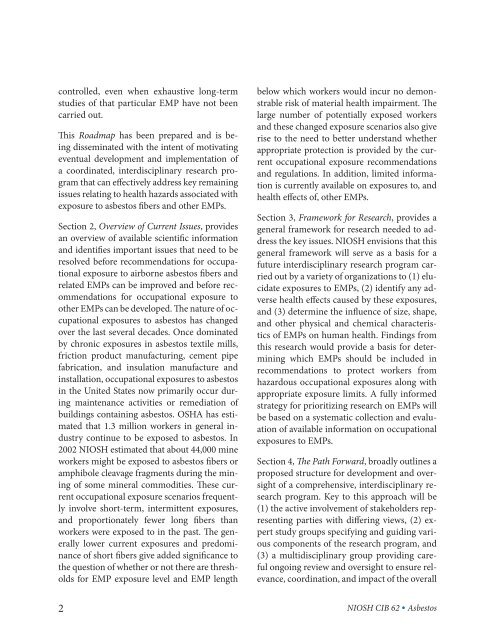Asbestos Fibers and Other Elongate Mineral Particles: State of the ...
Asbestos Fibers and Other Elongate Mineral Particles: State of the ...
Asbestos Fibers and Other Elongate Mineral Particles: State of the ...
- No tags were found...
You also want an ePaper? Increase the reach of your titles
YUMPU automatically turns print PDFs into web optimized ePapers that Google loves.
controlled, even when exhaustive long-term<br />
studies <strong>of</strong> that particular EMP have not been<br />
carried out.<br />
This Roadmap has been prepared <strong>and</strong> is being<br />
disseminated with <strong>the</strong> intent <strong>of</strong> motivating<br />
eventual development <strong>and</strong> implementation <strong>of</strong><br />
a coordinated, interdisciplinary research program<br />
that can effectively address key remaining<br />
issues relating to health hazards associated with<br />
exposure to asbestos fibers <strong>and</strong> o<strong>the</strong>r EMPs.<br />
Section 2, Overview <strong>of</strong> Current Issues, provides<br />
an overview <strong>of</strong> available scientific information<br />
<strong>and</strong> identifies important issues that need to be<br />
resolved before recommendations for occupational<br />
exposure to airborne asbestos fibers <strong>and</strong><br />
related EMPs can be improved <strong>and</strong> before recommendations<br />
for occupational exposure to<br />
o<strong>the</strong>r EMPs can be developed. The nature <strong>of</strong> occupational<br />
exposures to asbestos has changed<br />
over <strong>the</strong> last several decades. Once dominated<br />
by chronic exposures in asbestos textile mills,<br />
friction product manufacturing, cement pipe<br />
fabrication, <strong>and</strong> insulation manufacture <strong>and</strong><br />
installation, occupational exposures to asbestos<br />
in <strong>the</strong> United <strong>State</strong>s now primarily occur during<br />
maintenance activities or remediation <strong>of</strong><br />
buildings containing asbestos. OSHA has estimated<br />
that 1.3 million workers in general industry<br />
continue to be exposed to asbestos. In<br />
2002 NIOSH estimated that about 44,000 mine<br />
workers might be exposed to asbestos fibers or<br />
amphibole cleavage fragments during <strong>the</strong> mining<br />
<strong>of</strong> some mineral commodities. These current<br />
occupational exposure scenarios frequently<br />
involve short-term, intermittent exposures,<br />
<strong>and</strong> proportionately fewer long fibers than<br />
workers were exposed to in <strong>the</strong> past. The generally<br />
lower current exposures <strong>and</strong> predominance<br />
<strong>of</strong> short fibers give added significance to<br />
<strong>the</strong> question <strong>of</strong> whe<strong>the</strong>r or not <strong>the</strong>re are thresholds<br />
for EMP exposure level <strong>and</strong> EMP length<br />
2<br />
below which workers would incur no demonstrable<br />
risk <strong>of</strong> material health impairment. The<br />
large number <strong>of</strong> potentially exposed workers<br />
<strong>and</strong> <strong>the</strong>se changed exposure scenarios also give<br />
rise to <strong>the</strong> need to better underst<strong>and</strong> whe<strong>the</strong>r<br />
appropriate protection is provided by <strong>the</strong> current<br />
occupational exposure recommendations<br />
<strong>and</strong> regulations. In addition, limited information<br />
is currently available on exposures to, <strong>and</strong><br />
health effects <strong>of</strong>, o<strong>the</strong>r EMPs.<br />
Section 3, Framework for Research, provides a<br />
general framework for research needed to address<br />
<strong>the</strong> key issues. NIOSH envisions that this<br />
general framework will serve as a basis for a<br />
future interdisciplinary research program carried<br />
out by a variety <strong>of</strong> organizations to (1) elucidate<br />
exposures to EMPs, (2) identify any adverse<br />
health effects caused by <strong>the</strong>se exposures,<br />
<strong>and</strong> (3) determine <strong>the</strong> influence <strong>of</strong> size, shape,<br />
<strong>and</strong> o<strong>the</strong>r physical <strong>and</strong> chemical characteristics<br />
<strong>of</strong> EMPs on human health. Findings from<br />
this research would provide a basis for determining<br />
which EMPs should be included in<br />
recommendations to protect workers from<br />
hazardous occupational exposures along with<br />
appropriate exposure limits. A fully informed<br />
strategy for prioritizing research on EMPs will<br />
be based on a systematic collection <strong>and</strong> evaluation<br />
<strong>of</strong> available information on occupational<br />
exposures to EMPs.<br />
Section 4, The Path Forward, broadly outlines a<br />
proposed structure for development <strong>and</strong> oversight<br />
<strong>of</strong> a comprehensive, interdisciplinary research<br />
program. Key to this approach will be<br />
(1) <strong>the</strong> active involvement <strong>of</strong> stakeholders representing<br />
parties with differing views, (2) expert<br />
study groups specifying <strong>and</strong> guiding various<br />
components <strong>of</strong> <strong>the</strong> research program, <strong>and</strong><br />
(3) a multidisciplinary group providing careful<br />
ongoing review <strong>and</strong> oversight to ensure relevance,<br />
coordination, <strong>and</strong> impact <strong>of</strong> <strong>the</strong> overall<br />
NIOSH CIB 62 • <strong>Asbestos</strong>

















